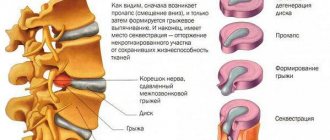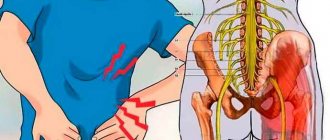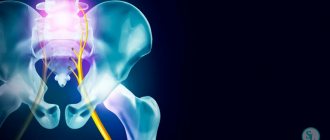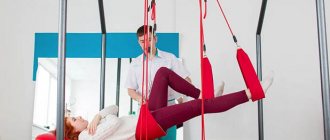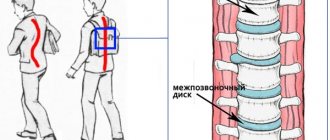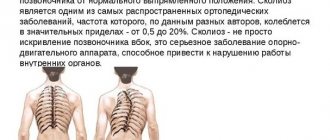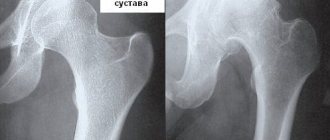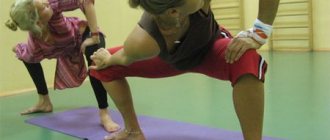In medicine, the term sciatica refers to inflammation of the sciatic nerve, provoked by various ethological factors. The disease can be the result of infectious lesions, diseases of the pelvic organs, hernia, spinal injuries, displacement of the vertebrae or discs. Treatment of the disease is usually comprehensive, and is aimed at eliminating the cause and relieving symptoms. An important component of therapy is gymnastics for sciatica, represented by a large number of complexes. Exercises are selected individually. Let's consider what they can be.
Signs of inflammation
Inflammation of the sciatic nerve makes itself felt by the following signs:
- Sharp pain when bending forward. Neuralgia in the buttocks, which can get worse.
- Unpleasant sensations in the buttocks and lower back.
- When moving, sharp and unexpected pain is possible.
If you notice these symptoms, consult your doctor immediately. Otherwise, the sciatic nerve may become even more inflamed and the pain will intensify.
For sciatica, it is recommended to do a light stretch every two hours if you sit for a long time. Proper nutrition is also important. Women are advised to avoid wearing high heels.
Treatment method
The goal of treatment is to eliminate the factors that caused the pinched nerve and relieve pain.
Note!
During an exacerbation, symptomatic therapy is necessary. The use of gymnastic exercises at this time is inappropriate.
To relieve pain from sciatica, analgesics, muscle relaxants, hormones and other drugs are used to improve blood flow and restore damaged tissues.
After the pain is relieved, it is important to restore adequate nutrition to the damaged tissues and free movement of the patient. At this stage, restorative therapy is indicated, which consists of the following procedures:
- Massage;
- Magnet therapy;
- Darsonvalization;
- Physical Culture.
Therapeutic exercise for inflammation of the sciatic nerve allows you to activate blood flow and prevent relapse of the disease.
Exercises for sciatica of the sciatic nerve: basic rules
Exercises should be prescribed by a doctor individually. He explains how to do them correctly, and in the future you can do them yourself.
Therapeutic exercises for sciatica should be performed in accordance with the following rules:
- The complex must be performed every day, preferably twice a day.
- It is recommended to perform exercises on a flat and hard surface. There should be no drafts in the room. It is best to lay a rug or mat on the floor.
- If inflammation worsens, you need to temporarily stop gymnastics.
- Exercises are done at a moderate pace. Fast and sharp turns, bending, standing up, etc. are prohibited. Jumping is contraindicated for sciatica.
Rules for performing exercises
In order for exercises for the treatment of the sciatic nerve to bring only benefits, it is necessary to follow the basic rules for their implementation. These include:
- You should start doing any exercises with 7-15 repetitions, gradually increasing their number as you feel better;
- a set of exercises must be performed several times a day;
- the duration of treatment of sciatica with therapeutic exercises should be determined by the attending physician;
- If you experience pain, deterioration in well-being or other symptoms, you should immediately stop gymnastics.
If you follow the rules of therapeutic exercises, sciatica will quickly go away and will not bother you for a long time. You can perform the exercises at home and in specialized groups.
It should be understood that in addition to therapeutic exercises, drug therapy may also be required to eliminate inflammation of the sciatic nerve.
A set of exercises for sciatica
The exercises listed below should be performed during the period when severe pain has passed. During exacerbation, they are contraindicated because they are not aimed at relieving pain. The exercises are performed in three positions - lying, standing and sitting.
The following exercises are performed while lying down:
- Lying on your back, pull your two knees to your chest and clasp your buttocks with your hands. Stay in this position for half a minute, return to the starting position. Repeat ten times.
- Lying on your back, grab your left knee with both hands and very smoothly pull it towards your right shoulder, hold for 8 seconds, then lower. The same is repeated for the right leg. Repeat 10 times.
- Lie on your back, bend both legs, and try to press your spine into the floor with your back muscles. Stay in this position for half a minute, then relax. Do 10 reps.
- Lie on your side with your toes pointed out. Bend your legs, try to pull them as close as possible to your chest, and then slowly straighten them. Do it 10 times.
- Lie on your stomach, lean on your arms bent in front. Extending your elbows, stretch your back as much as possible, aiming your head up. The legs should not rise at the same time. After a few seconds, slowly and carefully lower yourself to the floor. To begin with, it is enough to do five repetitions, and over time increase them to 15.
- Lying on your back, pull your feet closer to your buttocks and place them on the floor. Cross your arms over your chest. As you inhale, gently lift your torso until your shoulders are completely off the floor. As you exhale, return to the starting position. Perform at least 15 times.
Physical exercises for sciatica while sitting:
- Sitting on the floor, extend your legs straight forward. Raise your arms straight to shoulder level, try to place them behind your back as much as possible, while connecting your shoulder blades. Movements should be smooth, without jerking. Do it five times.
- Sit on the floor, raise your arms above your head and gently lower yourself onto your back. Then smoothly raise your legs wide apart at a right angle. At the same time, make sure that the shoulder blades do not come off the floor, as well as the lower back, as this puts additional stress on the spinal column.
- While sitting on a chair, perform body turns with your hands behind your head. To begin with, it is enough to perform five repetitions in each direction.
Exercises in a standing position:
- Stand straight, stretch your back as much as possible, place your feet shoulder-width apart. Raise your right hand up, lower your left along your body. Lean to the left so that your right hand is positioned clearly above your head, without moving either back or forward. Bend over until your arm and body are parallel to the floor surface. Then return to the starting position, inhale, and as you exhale, bend to the right. Do five repetitions for the right side.
- Keeping your back straight, kneel, clasp your fingers and extend them above your head. Gently lean forward until your hands touch the floor, then carefully straighten up. Repeat 5-10 times.
There is also physical therapy for sciatica, aimed at relieving severe back pain, which in this condition is a consequence of compression of the sciatic nerve roots. The following two exercises will help you cope with this:
- Stand facing any horizontal surface that is approximately at the level of your hip joints. You can use a table, bed and so on. Gently place your body on this surface and relax. Inhale deeply, inflating the abdominal walls, hold for 4-5 seconds and exhale as much as possible. The number of repetitions must be at least three.
- Get down on the floor, rest on your hands and knees. At the same time, your back should be kept in a neutral position, without bending. Relax your neck, lower your head down. Inhale slowly from your belly, hold your breath for five seconds and exhale. Repeat this breathing exercise 7-8 times. This will help you feel the pain gradually subside.
Pinched sciatic nerve diagnosis: diagnosis
If the symptoms described above appear, it is important not to delay a visit to a specialist. You can contact either a general practitioner or a highly specialized neurologist. At the initial appointment, he will collect a thorough medical history, find out whether relatives have had degenerative diseases, and conduct a visual and tactile examination. To make a reliable diagnosis of a pinched sciatic nerve, the following studies may additionally be prescribed:
1. X-ray examination of the spinal column. This is the simplest method of diagnostic examination; it is used first. Most often, the study is carried out in two projections (direct and lateral). Based on the results of the x-ray, it is possible to detect degenerative-dystrophic pathologies (in particular, osteochondrosis), osteophytes and neoplasms (both benign and malignant).
2. Computed tomography. Unlike X-ray examination, computed tomography clearly visualizes the bone structures of the spinal column. With its help, it is possible to determine the degree of nerve pinching. Computed tomography is characterized by high efficiency; it can detect even small deviations from the norm.
3. Magnetic resonance imaging. This technique is completely safe and painless during the procedure. It allows not only to determine the degree of pinched nerve, but also the reason that provoked the development of the pathology.
If you suspect the presence of other pathologies, a specialist may prescribe a laboratory test - a urine test, a general and biochemical blood test. Often, differential diagnosis of pinched sciatic nerve with intervertebral disc herniation is carried out. The main distinguishing feature of a herniated disc from a pinched sciatic nerve is the longer course of the disease.
Pinched nerves, which are caused by muscle spasms, go away much faster, and therapy is easier. With a herniated disc, most often the symptoms of sciatic nerve neuralgia appear periodically and significantly intensify when the load is placed on the spinal column. It is not possible to completely get rid of them.
Gymnastics for sciatica according to Bubnovsky
Gymnastics for sciatica of the sciatic nerve using the Bubnovsky method has proven itself well. When developing complexes, the author advises taking into account the general well-being, age characteristics, and level of muscle fitness of the patient. It is also important to stick to the program, do the exercises consciously and not skip classes.
The initial set of exercises includes various movements aimed at stretching muscles and ligaments:
- Relaxing the lower back in a position on all fours (exercise “cat”).
- From the cat position, alternately arch your back as you inhale and arch your back as you exhale. Do up to 20 repetitions.
- In the same position, move with a stretching step, alternately moving your buttocks towards your left or right heel, stretch your free leg forward. Pull the arm opposite the extended leg forward as far as possible. Do up to 20 times.
- In a similar starting position, stretch your arms forward as much as possible, maintaining emphasis on your knees and elbows.
- Return to the starting position. As you exhale, lower your body to the floor, bending your arms, inhaling at the bottom, and straightening them again as you exhale. The heels simultaneously lower towards the buttocks. You should feel a stretch in your lower back muscles. Repeat 5-6 times.
- Lie on your back, bend your knees, place your heels closer to your buttocks, and place your hands under your head. Press your chin to your chest, and as you exhale, reach your knees with your elbows. As you inhale, return to a lying position, stretching your stomach. Repeat until you get tired.
- From a similar position, extend your arms along your body and lift and lower your pelvis as you exhale and inhale, respectively. Focus on your feelings. The optimal number of repetitions is 30 times.
Exercises in a lying position can be supplemented with an ice compress placed under the lower back. This will make it possible to relieve pain.
Signs of a pinched sciatic nerve
The disease can occur instantly (in case of injury) or gradually progress (in the case of worsening concomitant pathologies, for example, osteochondrosis). The severity of symptoms directly depends on the degree of nerve pinching. Severe pinching of the sciatic nerve is accompanied by the appearance of a number of symptoms. Most often, the disease affects only one side of the body, but there are cases of bilateral damage.
The most characteristic symptom of a pinched sciatic nerve is the appearance of pronounced pain. They can be of different nature (sharp, stabbing, aching or pulling), spread from the lumbosacral spine and pass through the buttock along the entire back of the leg to the feet.
In this state, a person’s motor activity is significantly limited and a feeling of weakness appears. He is not able to remain in the same position (sitting, lying or standing) for a long period of time, since the painful sensations practically do not stop. In this case, other symptoms of pinched sciatic nerve in the lower back may also occur. Some patients complain of decreased sensitivity in the affected areas, pain in the knees and a feeling of coldness in the lower limb.
During attacks, redness of the skin often appears, slight swelling and sweating occur. As a rule, at the beginning of the disease the painful sensations are not pronounced, but gradually begin to intensify. If the pathology is not treated, the entire lower limb will suffer - it will be difficult to bend and unbend, and subsequently the ability to move the foot and move the fingers will be completely lost. In particularly severe clinical cases, muscle atrophy of the lower limb is possible.
Yoga for sciatica
Yoga is very useful for inflammation of the sciatic nerve. It helps strengthen muscles, improves spinal flexibility and mobility. The following yoga movements are useful for sciatica:
- Sit on the floor, straighten your legs. Bend your right leg at the knee, the foot of the right leg is lifted behind the left leg and is located in line with the knee of the left leg. Turn your torso to the right. The left hand reaches behind the right knee and touches the floor. You need to stay in this position for a minute. Then change the position of your arms and legs and turn in the other direction.
- Stand straight and step forward with your right foot. Tilt your body, keeping your back straight, touch your right foot with your left hand, pull your right hand up, and turn your body to the right. Stay in this position for a few seconds. Afterwards the body needs to be straightened. Instead of your right hand, place your left hand and repeat the movement.
These exercises should be done slowly and smoothly. It is recommended to repeat them 2-3 times during the day.
Therapeutic exercises for inflammation of the sciatic nerve help alleviate the condition and relieve discomfort, promote muscle relaxation, and improve posture. However, it is usually not enough to completely cure sciatica. A full range of measures is needed, which also includes drug treatment, physiotherapy, a daily routine prescribed by a specialist and compliance with other doctor’s recommendations.
Physiotherapy may include the use of laser, magnetic field, and electrophoresis.
Another measure that may be indicated for sciatica is massage. It is recommended to do it during exacerbation of the disease. With gentle movements, begin to knead or stroke the lower back, back of the thigh, buttocks, legs, feet. Massage will help relieve unpleasant symptoms and reduce pain.
We invite you to watch a video that presents exercises that help in the treatment of sciatica.
Objectives of physical therapy and its varieties
For sciatica, performing therapeutic exercises solves 3 problems:
- Improves blood flow.
- Eliminates the inflammatory process.
- Activates metabolic processes.
Gymnastics for a pinched sciatic nerve eliminates “residual” pain in just 3-4 sessions. It affects not only the symptoms, but also the causes of pathological processes.
To achieve maximum effectiveness, all movements should be performed in accordance with the following recommendations:
- The implementation of the complex should be supervised by an experienced exercise therapy instructor;
- Training is prescribed twice a day;
- Movements are performed smoothly, without jerking;
- If an exacerbation occurs, training is interrupted;
- As soon as the pain subsides, training is resumed;
- The pace of classes is selected individually;
- The benefits will only come from regular exercise; you cannot take long breaks.
Despite the obvious benefits of exercise therapy, its use is strictly prohibited in the following cases:
- The patient has mental disorders;
- Frequent seizures of epilepsy occur;
- There are malignant formations;
- Suffered a spinal injury;
- The presence of a viral infection accompanied by high body temperature;
- Condition after heart attack and stroke.
The presence of these conditions requires mandatory consultation with an orthopedist and additional examination.
For sciatica, a complex of exercise therapy is used in three starting positions:
- Sitting;
- standing;
- Lying down.
Yoga and physiotherapeutic procedures are also used along with them.
Lying down
The exercise therapy complex for sciatica while lying down consists of 6 exercises, each of which is performed at least 10 times.
- Lying on your back, slowly begin to pull your leg bent at the knee towards your chest. Don't move for 10-12 seconds. Switch legs using the same movements. Then repeat them with both limbs at the same time.
- Without changing the starting position, place your feet as close to your buttocks as possible. Place your hands on your chest, crossing them. Take a deep breath and raise your back as high as possible. Exhale as you lower your back to the floor.
- Place your palms under your buttocks. Bend your knees high, imitating riding a bicycle.
- Stretch your arms to the sides, focusing on your palms. Raise your straightened legs and connect them. Tilt them to the right, then to the left, reaching an angle of 45 degrees.
- Roll over onto your stomach. Use your palms as support. Hands should be near the shoulders. Arch your back while slowly straightening your arms. Having reached the maximum possible “deflection”, fixate for a few seconds. Relax by lowering your stomach to the floor.
- Change position by turning on your side. Pull your legs towards you, which should be bent at the knees, taking the “embryo” position. Gently “stretching” the spine, tilt your head toward your chest with soft springy movements. Then slowly lie down on your side again.
Sitting
Exercises performed while sitting on the floor or in a chair are no less effective. They are done about 10 times each.
- Sit on the floor with your legs comfortably extended. Focus on your hands, moving them behind your back. Connect and separate the shoulder blades. Remember that movements should be performed very gently, slowly, to avoid sharp pain and discomfort.
- Without changing the sitting position, raise your arms and take a horizontal position, lowering to the floor. Then raise the straightened legs to the level of a right angle. Remember that your lower back should be “firm” on the floor. Otherwise, there will be excess pressure on the spinal column.
- Sit on a chair with your hands behind your head. Slowly turn your body to the right, then to the left.
- Sitting on the floor, straighten your legs. “Walk” forward on your buttocks, then back.
- Get on all fours, focusing on your knees and hands. Inhale and arch your back. Exhale, returning to the position on all fours.
- Sit back on the chair. Place your hands behind your back, clasping your palms. Turn your body to the right, then to the left.
